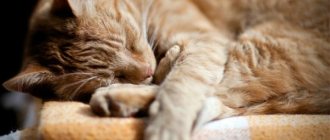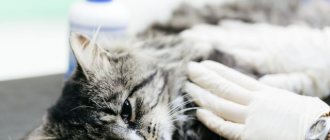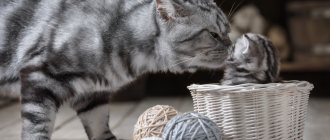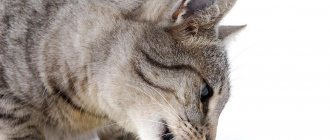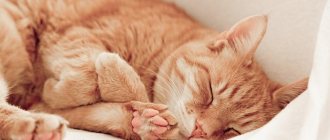The cat ate the rain: what to do?
Anecdotes from life about cats knocking down decorated Christmas trees no longer surprise anyone. But owners of furry animals are forced to show special New Year's decor from year to year. If a cat has eaten tinsel and vomits, you should immediately go to the doctor and save your pet. But what if the symptoms are not so clear?
Does the cat catch and eat frogs?
Our outdoor cat loves to hunt frogs and then eat them. Tell me, are frogs harmful to the health of cats? I heard that frogs contain poison that is dangerous to people. Anna
Is it good or bad? Anyway, that's normal. Frogs, along with mice and birds, have always been part of the cat's circle of prey. And cats treat them as they do with other small animals - they play, bring them to the owner’s porch for encouragement, and eat. The frog is usually eaten completely, while the toad eats only the hind legs, leaving the front part and skin. But this is not always good, because amphibians are different.
We will not go into the depths of zoology (more precisely, herpetology - the science of amphibians) and will roughly divide everyone jumping into frogs and toads. You can usually tell a frog from a toad by their appearance. The frog's skin is smooth and moist, sensitive to drying, which is why it prefers damp places. Toads have rougher, lumpier skin that is less dependent on humidity—they only enter the water to spawn.
In our country, common toads are the gray toad (gray-brown on top and yellowish below), the green toad (its lumpy skin is grayish-olive in tone with green spots), the reed toad (less lumpy, with a light stripe along the back) and the similar Mongolian toad .
There are a lot of different frogs in Russia. Let's consider only those that are highly undesirable to meet, and not only for cats.
Source
What happens to a cat who eats tinsel?
There are so many options - you were mistaken and he didn’t eat the tinsel. The next luckiest one was a piece of rain a few centimeters long. If it is a long thread, and one end of it has reached the animal’s throat, there is no way back. The cat's tongue is designed in such a way that everything that gets on it has only one path - into the esophagus and stomach. Cats cannot spit out the rain and are forced to swallow the entire thread. This is the third scenario. If a cat eats rain , you can get away with a slight fright and a not very pleasant procedure of inducing vomiting in the animal. To do this, you can use a water-salt solution or a few milliliters of Vaseline or castor oil, g of the intestine, and by simply starting the reverse effect, you can remove the foreign body.
Unfortunately, more often than not, the quartet happens and begins a dangerous game of confusion with it. Deadly. The thread gets tangled in the soil, there is no chance. This is the case when at first the cat vomits, his stomach hurts, his temperature rises, and problems arise with bowel movements. Without surgical intervention, death is inevitable. There are times when a cat has eaten the rain and it sticks out from under its tail . This is the exception when you seem to be lucky and the rain will come out naturally. BUT! Do not try to pull it out under any circumstances.
If you don't know how much rain your pet has eaten, it can also be very dangerous. And you will simply tighten the internal loops of the intestine into an even tighter knot, which can lead to disastrous consequences. The same applies to cases when a thread of rain sticks out of a pet’s mouth.
Language as a trap
In cats, curiosity sometimes outweighs caution, which leads to disaster. The desire to play with Christmas tree decorations and taste them is just such a case.
Take a closer look at the cat's tongue: it is covered with small papillae, resembling villi or hooks, which face the inside of the mouth, towards the pharynx. For this reason, the cat cannot spit out any foreign body that gets into its mouth; it is forced to swallow it.
Is it possible to foresee the danger?
Absolutely yes. Of course, I wouldn’t want to give up decorating my home, so we’ve put together key recommendations.
The first rule that all owners of purrs should follow is maximum attention to the design of their home. If your cat has been living with you for a long time, you probably already know his likes and dislikes and are able to clearly assess the risks and provide safety measures. For example, if you know for sure that the animal is partial to bright decorative items, seasonal decorations should be hung so that the cat has minimal access to them.
The second rule - try, if possible, to protect your pets from rooms with dangers: close the doors to the room where the Christmas tree is located, do not leave the fluffies alone with the decor.
the cat ate the tinsel, you can compare the current appearance of the room with how it was originally!-
Fourth rule: New Year will be your salvation for many people. More precisely, rescuing a pet. Place citrus fruits around the tree, spray citrus oil near it, on decorations - cats do not have a deep sympathy for these New Year's eating habits. But their interest in tinsel and other decorations will decrease.
Prevention is cheaper than cure
The operation is an expensive procedure. In addition, the cat will need quite a lot of time to recover its health. The pet will need to be given injections, tablets, and special medicated food, which is also not cheap. You can avoid all these expenses, save your nerves and your cat’s health by taking simple preventive measures.
To discourage your cat from playing with the rain, experts recommend spraying the area around the tree with a citrus-scented solution and spreading out lemon and orange peels. In addition, you can lubricate the trunk of the spruce and the tips of the branches with some spicy seasoning.
This has a deterrent effect on most cats, but not all. To completely eliminate the risk, you may want to avoid some Christmas decorations altogether.
Symptoms
You can tell that a dog ate a frog and was poisoned by the poison by the following characteristic signs:
- Very profuse salivation, white, thick foam begins to come out of the mouth.
- The eyes may roll, the dog does not respond to your voice, and may stagger
- Possible vomiting
- Loose stools
- Possible tachycardia and arrhythmia
- Weakness
- The dog may refuse water and food.
- Possible seizures
- The poison, if it comes into contact with the mucous membranes of the mouth, can cause swelling and severe redness
- In severe cases, there may be pulmonary edema or a severe allergic reaction.
Usually in medium and large breeds, the symptoms disappear after a couple of hours and the dog feels well. Many dogs experience no illness at all other than excessive foaming at the mouth.
But each dog’s body is individual and it is impossible to predict the reaction, so you should monitor your pet very carefully and, if necessary, take measures to alleviate your pet’s condition, and possibly save his life.
Adviсe. How to protect your animal from eating Christmas decorations as much as possible.
- Completely give up tinsel, “rain” and plastic garlands of beads!
- Use plastic rather than glass Christmas tree decorations, as well as artificial trees.
- Do not use Christmas tree decorations of small diameter or with decorative elements that can be chewed off by animals.
- If possible, do not allow the animal into the room where the Christmas tree is located. This way you will keep not only the animal safe and sound, but also the New Year’s decoration.
- Try not to hang decorations on the bottom of the tree so that the decorations are not in close proximity to the animal.
- Choose low-voltage electric lights to avoid severe electric shock.
- When decorating your apartment, try to remember what toys, garlands and streamers you hung and where. If you see that your efforts are lying chewed or torn on the floor, then it is worth collecting them and assessing whether all the parts are in place.
- Please note that those at risk for eating New Year's decorations are animals that have shown an interest in inedible objects throughout their lives.
Types of discharge in cats
How can a cat be poisoned? - plants indoors and outdoors
- medications (eg, acetaminophen, NSAIDs, antidepressants, methylphenidate). Eat both your tablets, left in an accessible place, and if you yourself give the animal any drugs prohibited for animals or an overdose/incorrect application, for example, when treating with parasite drops. Many people use drugs for dogs/people for cats, causing them to become poisoned. Remember, the medications you use should only be for cats or those prescribed by your veterinarian. And do not forget about dosages, strictly according to the weight of the animal or according to the doctor’s prescription.
— food poisoning (unsuitable food for cats, poor quality or spoiled). Strictly contraindicated - chocolate, caffeine, onions, garlic, fatty meats, purchased minced meat, citrus fruits, grapes/raisins, apricots, all types of mushrooms, persimmons, nuts, all products with spices, sausages, smoked meats, sweets, canned food for people and much more other. The diet must be balanced especially carefully if your cat is on a natural diet, because poisoning may not be acute, one-time, but will manifest itself over time as chronic pathologies. Try not to buy food in bulk; it can often be spoiled; manufacturers recommend keeping the packaging sealed.
- chemicals, disinfectants in the house, poorly washed floors or other parts of furniture with leftover products can also cause cat poisoning. In case of poisoning with detergents, there may be: Vomiting, diarrhea with blood, difficulty breathing in the animal, convulsions. It is necessary to immediately give a large amount of water and take the cat to the clinic.
- Lead contained in paint, linoleum and batteries - a cat can be poisoned if it eats it.
— Apartment renovation is not only a big stress for many cats, but also a cause of poisoning in animals, for example, when you glue wallpaper, paint and other substances may attract your cat to taste
What plants can poison a cat? Considering our case with fake grass Plants that are poisonous to cats, this is a whole epic. It is very important to limit the contact of cats' faces with some of the plants that owners love so much and unknowingly bring home
Lilies are very poisonous to cats, causing acute kidney failure, vomiting, and lethargy. Cycad palms - cause vomiting, constipation/diarrhea, mainly affecting the liver.
Azalea, laurel, and aloe can cause diarrhea. Begonia - burns mucous membranes.
Asparagus and geranium (the whole plant is poisonous to cats, but especially the leaves) – stomach upset
Other toxic plants - yew, autumn crocus, foxglove, lily of the valley, ivy, boxwood, cyclamen, cyperus, iris, narcissus, snowdrop, calla lilies, hyacinth, tulip, chrysanthemum, belladonna, adonis, aconite, acacia, henbane, geranium, wisteria, St. John's wort, jasmine, honeysuckle, tansy, hellebore, celandine, onion, tomato, elderberry, dandelion, physalis, ficus, rhubarb and violet.
Remember that cats do not always choose only what is beneficial for themselves and not all grass and plants that they can eat are harmless to them. It is important to grow flowers at home that are not dangerous to cats; gift bouquets should also be inaccessible to them.
What are the types of poisoning in cats in the summer, during the summer season? For example, if in the summer a cat is walking on its own in the countryside, when going outside, animals, including cats, are at risk of being poisoned by substances that can poison them - rats, cockroaches, chemicals that are sprinkled on roads.
Poisoning with rat poison can lead to various bleeding (a characteristic sign) and shortness of breath. The antidote, vitamin K1 konakion, is quite difficult to find in our pharmacies, and doctors in clinics may begin to use other hemostatic agents and then search for konakion.
Fertilizers on plots are also dangerous during the summer season. Lawn and garden products can be toxic to animals who ingest them when they wash themselves after walking or lying in a recently treated area.
Poisoning in cats living in an apartment - what must be hidden from the animal? It is important to keep all medications and chemicals out of the reach of animals. When they are poisoned, there can be either mild poisoning - vomiting, diarrhea, or fatal poisoning, due, for example, to acute renal failure.
The most common reason for visiting clinics is food poisoning, when they are fed either spoiled ready-made food or natural food unsuitable for animals.
Compared to poisoning with strong poisons, ingestion of inappropriate food is less likely to lead to acute life-threatening conditions, but causes chronic diseases. What does the liver, pancreas, and stomach most often react to? For any unfavorable signs, even mild ones, it is important to show your animal to a doctor and undergo the necessary tests, even if symptoms such as vomiting and diarrhea could be prevented on your own. A course of additional medications may be required.
Drug poisoning: what medications must be hidden from your cat? Paracetamol is contraindicated in cats; it can cause swelling of the face, cyanosis of the mucous membranes (cyanosis), shortness of breath, renal failure, gastritis/stomach ulcers. In dogs it can cause nausea, vomiting, lethargy, and pale mucous membranes, but may be asymptomatic.
Animals are also contraindicated in such painkillers - non-steroidal anti-inflammatory drugs such as ibuprofen and indomethacin - they are very toxic and can also cause poisoning aspirin, piroxicam, caroprofen, naproxen, phenylbutazone.
Their use with glucocorticoids is especially contraindicated. They can cause stomach ulcerations, stool and vomiting of blood (“coffee grounds”), abdominal pain, and acute renal failure. In case of poisoning with these drugs, it is necessary to induce vomiting, and in case of aspirin poisoning, the stomach can and should be washed out, even if 3 hours have already passed after poisoning, since aspirin can form conglomerates.
Our outdoor cat loves to hunt frogs and then eat them. Tell me, are frogs harmful to the health of cats? I heard that frogs contain poison that is dangerous to people. Anna
Oh, that hunting instinct! He and curiosity do not allow cats to pass by unusual croaking creatures.
Is it good or bad? Anyway, that's normal. Frogs, along with mice and birds, have always been part of the cat's circle of prey. And cats treat them as they do with other small animals - they play, bring them to the owner’s porch for encouragement, and eat. The frog is usually eaten completely, while the toad eats only the hind legs, leaving the front part and skin. But this is not always good, because amphibians are different.
What a cat owner should know about amphibians
In our country, common toads are the gray toad (gray-brown on top and yellowish below), the green toad (its lumpy skin is grayish-olive in tone with green spots), the reed toad (less lumpy, with a light stripe along the back) and the similar Mongolian toad .
Positive point: toads are nocturnal animals and only occasionally crawl out of secluded corners during the day.
Toadstool
- a small frog with a bright red or yellow belly with black speckles, which it flips onto its back and demonstrates to the enemy when attacking. At the same time, her skin glands secrete caustic, poisonous mucus. In spadefoots, the skin secretion has a specific garlic odor.
Positive point: you can’t see these frogs often, because during the day and in times of danger they burrow into the soil.
